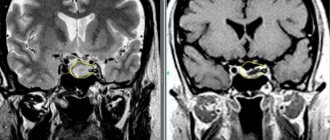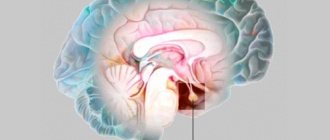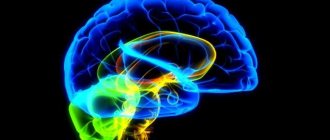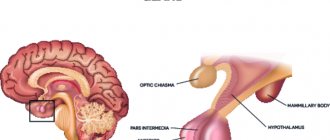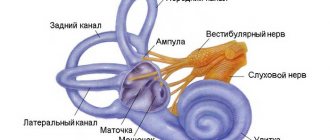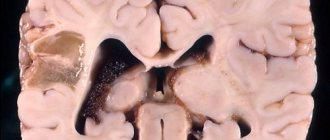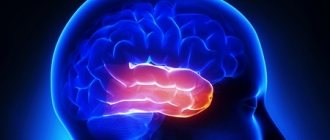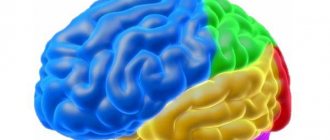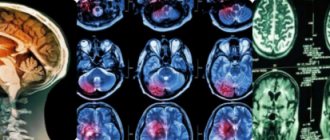A pituitary adenoma is a benign tumor that grows no more than 10 mm. Therefore, when making a diagnosis, it has the prefix “micro”. The tumor occurs more often than any other type of brain tumor.
Due to its small size, it is difficult to find the tumor. Signs of pituitary microadenoma do not appear in any way. The pathology is discovered by chance during an examination of the brain or blood vessels. Therefore, it is difficult to give an exact figure for the incidence among people.
The disease is believed to have no sexual priority. However, for the female pituitary gland, microadenoma is more common than for men. There is an assumption that the pattern is related to the functioning of the gland during pregnancy and the postpartum period. At this point, the pituitary gland actively produces hormones to maintain the vitality of other organs of the body.
Pituitary microadenoma is nothing more than an increase in the number of cells in the gland, due to which a benign tumor is formed. In medicine, this phenomenon is called hyperplasia.
Pituitary microadenoma is extremely difficult to diagnose. Therefore, as a precaution, when examining the brain, attention should be paid to possible neoplasms in the gland.
Causes of the disease, what are the consequences and prognosis?
Reasons for the development of microadenoma:
- Heredity;
- Neuroinfections: tuberculosis, brucellosis, polio, syphilis, encephalitis, meningitis;
- Various head injuries, bruises and concussions;
- Childbirth and pregnancy. Prolonged and uncontrolled use of contraceptive pills, frequent abortions;
- Underdevelopment of the testes and ovaries, the so-called hypogonadism syndrome. The syndrome can be either congenital or acquired, due to various reasons: radiation, autoimmune diseases, and so on;
- Age. In women, this disease occurs much more often with age;
- Weak production of thyroid hormones;
- Low adrenal gland performance.
In general, the treatment and prognosis of microadenoma is successful. With timely detection, diagnosis, prevention and mandatory treatment by neurosurgeons and endocrinologists, recovery occurs in 95% of cases.
The patient may be offered surgery to remove the tumor or undergo a course of treatment with pills.
Small tumors are more treatable than large tumors that put a lot of pressure on the surrounding tissue. If the patient refuses treatment altogether, the consequences may be irreversible.
Why does it appear
It is impossible to indicate the exact causes of pituitary microadenoma, but its appearance is influenced by heredity, gender (mainly found in women) and increased work of the pituitary gland.
The following factors are also important:
- skull and brain injuries;
- use of contraceptives;
- neuroinfections;
- pathological pregnancy;
- intoxication and infection, when inflammation spreads to the membranes and tissues of the brain;
- Among the causes of the disease, it is important to highlight overload of the pituitary gland that occurs during pregnancy, breastfeeding, adolescence, and termination of pregnancy.
Why is microadenoma dangerous?
In the human body, unfavorable changes in the functioning of internal organs may occur, and vision problems may appear. It will become difficult for a person to distinguish objects, since the eyes are very close to the growing tumor. Myopia or farsightedness may actively develop. Chronic migraine will form.
The normal functioning of the genital organs is disrupted. For men, this is a lack of testosterone and, as a result, problems in sexual life will begin. The amount of hair on your body will decrease and many stretch marks will appear. Diabetes and hypertension, as well as other life-threatening conditions, may occur.
The disease is also dangerous because it disrupts mineral metabolism in the body, and this will ultimately lead to skeletal disease (the bones of the body will become fragile, the risk of injury or fracture will increase). All this will ultimately lead to disability. Therefore, treatment for such a disease should not be delayed.
Prevention
There are no specific measures to prevent this disease, but measures should be taken to reduce its progress:
- It is necessary to correct hormonal changes.
- Consult a doctor at the first symptoms of the disease.
- Treat inflammatory diseases of the brain, neuroinfections of the spinal cord, and observe measures to prevent their occurrence.
- Follow the doctor’s prescriptions and recommendations if the diagnosis has already been established.
The prognosis of the disease is always favorable if treatment is started in the early stages. It has been proven that the tumor can disappear on its own and stop producing hormones.
Types of disease
Pituitary adenomas exist in the following varieties:
- Foltropin producing (gonadotropic). It produces gonadotropic hormones. This type of disease is dangerous, since if the tumor is large, signs of the disease itself may not appear. There will be a risk of developing cancer;
- Somatotropin producing (somatotropic). Produces growth hormone somatotropin. If such a disease occurs in childhood, the child will grow very tall. If the disease occurs in middle or old age, it will lead to another disease - acromegaly. The bones of the skull, hands, and feet will increase in size, expand and thicken, especially the facial part;
- Prolactinoma. It synthesizes prolactin. It is considered the most common adenoma among women, since the hormone prolactin is released in large quantities in women, disruptions occur in the menstrual cycles, body weight increases and this reduces the chance of getting pregnant. As for men, in addition to impotence and obesity, the size of their mammary glands increases;
- Adrenocorticopine producing (adrenocorticotropic). Releases adrenocorticotropic hormone;
- Thyrotropin producing (thyrotropic). Produces thyroid-stimulating hormone and thyroid function increases. This can lead to hyperthyroidism or goiter.
- Corticotropinoma. This type of disease leads to rapid aging of cells and the development of Cushing's syndrome, and this disease will cause catabolism in the body. There will be a breakdown of bones, skin, muscles and internal organs. The heart muscle will suffer greatly, leading to arrhythmia and heart failure. Cushing's syndrome is characterized by mental disorders. Symptoms of corticotropinoma include severe obesity in the abdomen, face and neck, and the limbs become thin.
General symptoms
The symptoms of adenoma have a wide range of manifestations, which include the following general symptoms (signs of microadenoma) for both men and women:
- Hypoxia (oxygen starvation);
- The appearance of papillomas, warts, birthmarks on the skin;
- Symptoms in men are as follows: deterioration in the field and visual acuity, atrophy of the optic nerves occurs, and sometimes even blindness, since the tumor strongly presses the visual nerves, problems with potency appear;
- Decreased performance and constant fatigue, insomnia, high blood pressure and hypertension. Increased skin greasiness and sweating appear;
- Numbness, goose bumps, tingling sensation, pain in the limbs and decreased sensitivity in them;
Pituitary adenoma of the brain
- Migraine attack. Headaches that are concentrated in the frontal, temporal and orbital areas. The pain may get worse suddenly;
- Chronic runny nose;
- Cramps and spontaneous muscle contractions;
- A person may gain weight quickly;
- Symptoms in women are behavioral disorders. The goiter (thyroid gland) increases noticeably. A tumor in women can cause weight gain. Many women who come to the clinic complain that milk is secreted in the mammary glands, but there is no pregnancy or small child. Due to the tumor, the activity of the ovaries decreases and this leads to changes in the menstrual cycle, and conceiving a fetus in this case becomes impossible, even if sex could be regular. The woman will experience a decrease in libido and become frigid;
- Stretch marks, so-called scars, may form in the abdomen and chest area;
- There is a constant feeling of thirst;
- The structure of the face may change;
- The toes are noticeably enlarged. The feet themselves also thicken in size.
If you use analgesic medications, it will be ineffective, and often will not bring any relief at all. If the growth of the tumor continues to the upper region, then damage to the structure of the hypothalamus will begin, that is, the neuroendocrine system of the brain and visual acuity may deteriorate in both eyes or in one. If the tumor grows downward, nasal congestion and leakage of so-called cerebrospinal fluid will be observed. In addition, breathing will also be impaired. If the tumor grows to the side, then signs of nerve damage will appear. There is a possibility that it will enter the eye orbit, which will cause the apple of the eye to be squeezed out and then Graves’ disease will occur, or, more simply put, “bulging eyes.” As for contraception for pituitary microadenoma, in this case it is allowed, but it is necessary to take into account the characteristics of the body’s blood. Blood clotting and the important hormone prolactin should be normal. The mammary glands should also be in order.
Mode
The main task is to prevent further growth of the tumor. In this regard, any action that can provoke its growth is a contraindication.
Forbidden:
- Breastfeed your baby.
- Take hormonal birth control pills.
The dependence of the occurrence of pituitary adenoma on long-term use of oral contraceptives has been traced
- Gain weight. Contraindications are obesity, excess weight and unhealthy diet that contributes to obesity.
Treatment and contraindications for the disease
Currently, microadenoma can be treated with medication, surgery, or radiation therapy.
Most often, these tumors require combination treatment. Depending on the stage of the tumor and its size, an individual treatment option is chosen. But first, before starting treatment, it is necessary to take tests for the level of sex hormones and the thyroid gland, as well as the adrenal glands. And in order for the picture of the disease to be complete, it is necessary to conduct magnetic resonance imaging.
The most effective method is surgical removal of the tumor. It can be removed frontally using an optical device or by a resection procedure (that is, partial removal of part of the tumor). And in addition to the effectiveness of the procedure, in order to suppress the activity of infected cells, radiation therapy is used, which affects this area with ionizing radiation. But radiation therapy is used if the treatment is associated with a hormonally inactive microadenoma or when there are contraindications to the surgical method. After surgery, the recovery period is accompanied by a hormone replacement procedure. Appropriate types of hormones are used. If necessary, to restore the electrolyte balance of the body, special correction procedures are used, insulin therapy is carried out, that is, insulin devices are introduced into the patient’s body and thereby improve carbohydrate metabolism. The use of medications depends on what type of hormone is exceeded in the body and whether the tumor can respond to the effects of the medication. With the help of medications, complete disappearance of the tumor can be achieved in about 1.5–2 years. For example, for prolactinoma, drugs such as Parlodel, Cabergoline, and Somatostatin have a good effect.
Folk remedies also help a lot. You can start this method only after the official permission of the doctor who is treating you, and also if there are no contraindications.
Pituitary microadenoma can be treated with various herbal infusions. Herbs such as lemon balm and mint are very effective. These herbs are used as food additives. For children and adults, a tincture of a two-year-old herbaceous plant, hemlock, can be instilled into the nose. All of the herbs listed are suitable for the treatment of passive microadenoma.
Inactive pituitary adenoma
The following remedies will need to be used to cure the active form of microadenoma.
A tincture of bug grass can bring good results. You can prepare the tincture yourself, but it will be easier if you buy it at the pharmacy. This tincture is taken 3 times a day, 10 drops each, and washed down with a glass of water.
You can prepare a mixture that will include: pumpkin seeds, sesame seeds, ginger, perennial plant “primrose” and honey. All ingredients should be mixed in equal proportions, and they should be taken 4 times a day, one teaspoon.
There is also a decoction of plantain, sage, valerian and rowan berries. This decoction can be prepared very quickly. Take a teaspoon of each herb, mix it all and pour boiling water over it. Boil the mixture for one hour. Then strain everything, and then take approximately 100–130 ml 3 times a day.
It would be naive to believe that the tumor will go away very quickly if such treatment methods are used. But if you take both medications and herbs, combining all this, then the activity of the tumor may decrease to nothing. Tinctures and decoctions will not help normalize the hormonal levels. Moreover, some herbs that are used to treat microadenoma can be poisonous. Doctors do not recommend taking such herbs, as they will harm healthy organs.
Contraindications for treatment of pituitary tumors:
- One of the contraindications is intolerance to anesthesia during surgery;
- Various tumor complications;
- In addition to the microadenoma itself, the presence of other diseases;
- Allergy reactions.
How to eat with pituitary microadenoma?
For the pituitary gland to function normally, you need to eat right. Various flavor enhancers, dyes, and preservatives should be excluded from the diet, as they disrupt the conductivity of nerve trunks. Among the useful products it is worth highlighting:
- Chicken eggs. They contain many microelements and vitamins. But most importantly, eggs contain a pigment that is very important for the pituitary gland - lutein. The human body does not synthesize this pigment and therefore it is very important to obtain it from food;
- Chicken fillet. The fillet has proteins that play the role of building material for new cells. The B vitamins and selenium contained in this chicken are simply irreplaceable for the pituitary gland;
- Different types of fish, preferably fatty ones. Eating fish is very beneficial, as it prevents the deposition of cholesterol and effectively stimulates the production of hormones, and also balances all the endocrine glands of the body. The most useful are herring, salmon and mackerel;
- Spinach. Spinach contains a lot of iron. Iron increases the level of hemoglobin in the blood and thereby improves blood supply to the pituitary gland. The antioxidants contained in spinach fight harmful formations and tumors in the body. In addition, spinach has a positive effect on the central nervous system, as it contains many vitamins A and C;
- Sea cabbage. The product is very useful for insomnia and irritation. It is known to contain a lot of iodine and improves the transport of oxygen to the brain;
- Walnuts. The nut contains many trace elements: iodine, iron, cobalt, zinc and magnesium. Nuts contain a lot of zinc, and it is known to prevent rapid aging of the body. Nuts also contain many healthy fats and vitamins. All this together stimulates the work of the pituitary gland;
- Carrot. It is known to be rich in beta-carotene, and also slows down the aging of the body, stimulates the regeneration of new cells and improves the conductivity of nerve impulses;
- Dark chocolate. With this type of chocolate, nerve cells and blood vessels are stimulated. Brain function improves;
- Honey, dried apricots and tangerines.
If you have a pituitary microadenoma, it is strictly forbidden to consume the following foods:
- Products that have a long shelf life. These include sausages, mayonnaise, sauces, chips, crackers, etc.;
- Very fatty meat products. Such products contain very high cholesterol, due to which cholesterol plaques can form in blood vessels and, as a result, the conductivity of such vessels decreases, which leads to oxygen starvation of the pituitary gland.
- Alcohol. Such drinks lead to vascular spasms and, as a result, the nutrition of cells is disrupted, which violates their integrity. In addition, after each glass of alcohol consumed, a large number of neural networks in the brain die, which has an extremely negative effect on its overall functioning.
- Salt. Due to salt, the nerve fibers become overexcited and therefore the nerves begin to function worse.
In conclusion, it is worth noting that after recovery, the patient must definitely consult with his doctor: when and at what time he should prevent various diseases. Regular examination by a doctor (once a year is enough) will prevent the development of these diseases and give confidence in your health and tomorrow.

